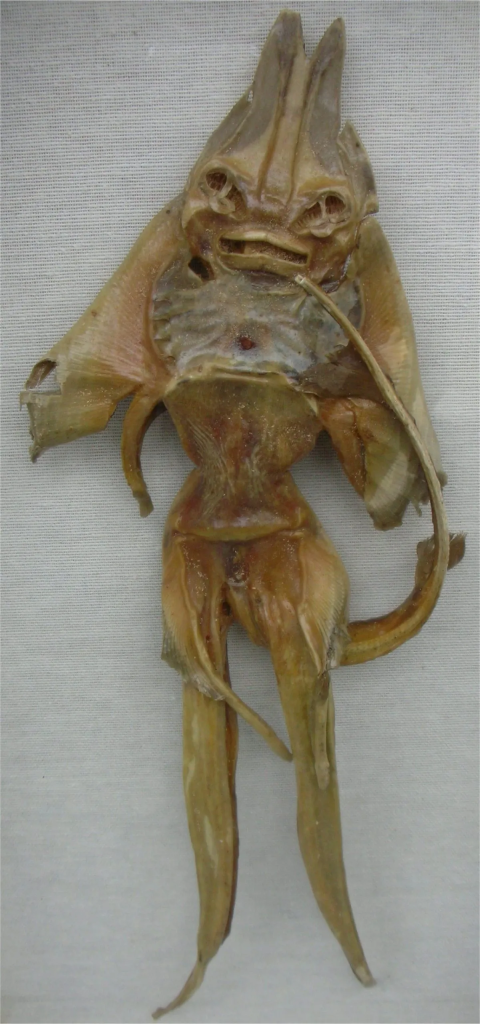In the 16th century, as sailors traversed uncharted seas and returned home with tales of mythical creatures, they brought more than just stories. They crafted curiosities that blurred the line between myth and reality, sparking awe and wonder among the people they encountered. Among the most fascinating of these creations were the Jenny Hanivers—bizarre, manipulated fish transformed into “mermaids,” “devil fish,” and other fantastical sea creatures. These eerie artifacts captivated imaginations for centuries, weaving themselves into the rich tapestry of maritime folklore.
What Are Jenny Hanivers?

Jenny Hanivers are not natural creatures but cleverly altered fish, typically rays or skates, preserved and shaped to resemble mythical beings. Through careful manipulation, sailors would bend and dry the fins, carve facial features, and craft creatures that seemed otherworldly.
These eerie figures often featured human-like forms, with fish tails and exaggerated features that made them look like a cross between a mermaid and a demon. Tourists and traders, enamored by the mysteries of the sea, eagerly purchased these “proofs” of mythical creatures.
The Craftsmanship Behind Jenny Hanivers
Creating a Jenny Haniver was a meticulous process. Sailors would begin by capturing rays or skates, cartilaginous fish with flat bodies and wing-like fins. After cleaning the fish, they would preserve it by drying it in the sun or curing it with salt.
Once preserved, the real artistry began. The fins were bent to mimic arms or wings, while the body was shaped into a humanoid or monstrous form. In some cases, sailors would carve facial features like eyes, mouths, and even grotesque expressions into the fish to make the creature appear lifelike.
The result? A chilling yet fascinating figure that seemed to defy explanation—a true testament to the creativity (and cunning) of these maritime artisans.
Why Sailors Made Jenny Hanivers
During the Age of Exploration, public fascination with the unknown was at its peak. Sailors, often strapped for cash after long voyages, found a lucrative market in crafting and selling Jenny Hanivers.
These bizarre creations tapped into humanity’s enduring curiosity about the supernatural and the uncharted depths of the sea. Whether sold to passing traders, curious tourists, or collectors, Jenny Hanivers were presented as tangible evidence of the mythical creatures sailors claimed to encounter on their travels.
For sailors, the appeal of these hoaxes went beyond financial gain. Creating Jenny Hanivers was a way to pass the time on long voyages, share stories, and bring a piece of maritime mystery to shore.
The Myth vs. Reality
Despite their manufactured origins, Jenny Hanivers often sparked genuine belief and superstition. To an untrained eye, these grotesque figures could easily pass as evidence of sea monsters or mermaids.
In a time before widespread scientific knowledge, such artifacts fueled tales of underwater realms teeming with mythical creatures. For many, owning a Jenny Haniver was like holding a piece of the unknown—a tangible connection to the mysteries of the sea.
However, as science advanced and the truth behind these creations became widely known, their allure shifted from belief to curiosity. By the 19th and 20th centuries, Jenny Hanivers were seen more as quirky collectibles than as proof of mythical creatures.
Jenny Hanivers in Modern Times

Though their heyday has passed, Jenny Hanivers continue to intrigue historians, collectors, and fans of maritime lore. They often appear in museums, historical exhibits, and curiosity shops as relics of a time when storytelling and craftsmanship converged to create myths.
Some modern artists and artisans have revived the tradition, crafting Jenny Hanivers as a form of folk art. These contemporary creations pay homage to the ingenuity of the sailors who first popularized them, while also catering to today’s fascination with oddities and the macabre.
The Enduring Appeal of Jenny Hanivers
What makes Jenny Hanivers so fascinating, even centuries later? Perhaps it’s their eerie blend of artistry and deception—or the way they embody humanity’s desire to make sense of the unknown. They serve as a reminder of how myths and legends are often born: from a mix of creativity, curiosity, and a touch of mischief.
These fish-turned-monsters are more than just souvenirs of a bygone era. They are symbols of an age when the world was full of unexplored frontiers, and the line between reality and fantasy was deliciously blurred.
Conclusion: A Quirky Legacy of Maritime Mythology
Jenny Hanivers remain a unique chapter in maritime history, blending craftsmanship with the art of storytelling. They stand as a testament to the creativity of sailors, who turned ordinary fish into extraordinary relics that fueled the imagination of generations.
Whether displayed in a museum, tucked away in a collector’s cabinet, or crafted anew by modern artists, these mythical creatures continue to enchant. They remind us of a time when the world felt bigger, its mysteries deeper, and its stories richer.
The next time you hear tales of mermaids or sea monsters, think of the Jenny Haniver—a creature born not of the sea but of human ingenuity and a timeless love for the fantastical.


